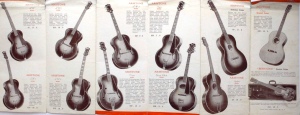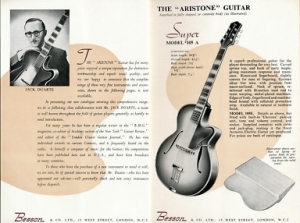Aristone Guitars
John George Abbott (1877-1938) In 1901 he went to Supervise the Production of Barnes & Mullins Banjos in Harrow. He left to start his own Company J G Abbott & Co in Hampstead Road, London in 1905. He made Banjos under his own name and for several of the other ‘Names’ in the Banjo Business such as Norton Greenop, Charles Skinner, John Alvey Turner & Len Shevill, Hawkes. His son (also John George 1905-1994 but known as Jack) learnt the Trade & in the Late-1920s & 1930s father & son worked together producing Guitars, banjos & banjo ukuleles at their Workshop in London which had moved in 1928 to Chalton Street. When J G Abbott grew ill in 1936 & gave up the Business, Jack started on his own producing Guitars, occasional banjos & banjo ukuleles. Around this time, Besson’s acquired J G Abbott & Co. Jack made Instruments until the mid-1950s when he retired ^ returned to the Stock Exchange which suggests that he initially Trained for & worked there before becoming an Instrument Maker. He also moved out of London to Cambridgeshire where he was persuaded out of Retirement in 1970 to make around 200 Banjo Ukuleles for the George Formby Society over the next 8-yrs.
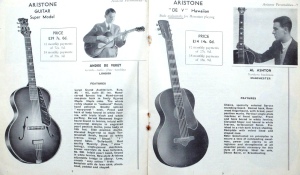
The easy way to tell a John G Abbott from a Jack Abbott is this: A John G Abbott the Top is made from a solid piece of Spruce & the inside Braces are actually Carved into the underside of the Top. The Jack Abbott uses Glued on Braces. The black & white Catalogue pictures are from the 1930s when John G Abbott Sr was making the proper old Aristones. He died in 1938 and his Son also named Jack Abbott held the Brand name with Besson.
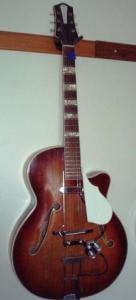
The Aristone Guitars are often reportedly made by Framus, however, this one isn’t. It may have been made by Abbott before demand outstripped his supply capacity in the early 60s and the explosion of pop & they started to Sub-contract to Framus. It’s very much like a Gibson L7, Tobacco Sunburst, 21– Frets. Rosewood Fingerboard with dot inlay (unbound), solid Spruce (not ply) top with single cream binding, Sycamore Neck with a V-Profile & Sycamore back & sides again Solid not Ply, Sycamore being the English Maple & in plentiful supply at the time. Nickel-plated Trapeze Tailpiece & floating Rosewood Bridge. It has very early open-back Grover Machine Heads with Cream Buttons. The Headstock has a small rectangular Ivory Label at the top with The Aristone (Aristone in Copper Plate). It does not appear to have a Truss Rod, but tolerates 11‘s ok. It really is a stunning Guitar, definitely not Framus or East German. The build quality is far too good for a Factory Mass-produced Model. It used to belong to a Newcastle Session Guitarist from the 50s/60s Charlie Smith, who owned it in the mid-80s. Graham Heath
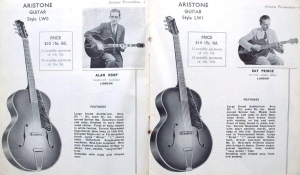
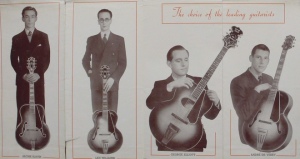
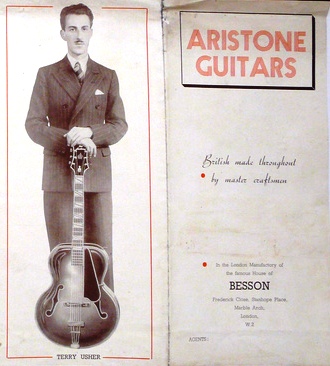
Framus: The name being an Acronym of FRAnconian MUSical Instruments. Framus originated in the Town of Schönbach, today called Luby (Cheb District) in the Czech Republic. The City at the foot of the Erzgebirge was shaped by the Music. Violins & other String Instruments have been manufactured & exported from Schönbach Worldwide. There, in the Bohemian area, the Founder of Framus, Fred Wilfer was born in 1917. After WW2, when he heard about plans to expel Sudeten Germans from post-War Czechoslovakia, he decided to build up a new basis for his Countryman & the Busic Industry in the West. Besson Guitars were also later produced in the 1950s. These Guitars were imported and often rebranded. Many of them were made by Framus. In the 50s; Jack Duarte, as a British Jazz Guitarist, designed the Aristone Guitars for Besson that were made by Framus. They were Badged as Besson Aristone Model. The Aristone Guitar was Sponsored by John Duarte, alias Jack Duarte, a Classical & Jazz Guitarist. This Instrument was probably made in the 60s.
The Link with Hofner Guitars: The German Brand Höfner Founded in 1887 in Schönbach (present Czech Republic) by Karl Hofner. Already before the WW1 the Company had a good reputation, even outside Germany’s Borders, because of the Artisans great skill & probably also because Karl Hofner was a clever Businessman. His sons Josef & Walter joined the Company in 1919 & 1921 & it gave further Impetus to Exports.
Immediately after WW2, the victorious Allies set about re-defining the Map of Europe & as part of this process, Schoenbach became part of Czechoslovakia. Hofner‘s Business was very quickly taken into State Control & those German-speaking people living in the Sudetenland, as the area where Schoenbach was now, were forced to re-locate into Germany. So it was that the Walter Hofner found himself in Moehrendorf, near Erlangen, (which lies just to the North of Nuremberg), in Bavaria. Here, in 1947, he began working with Fred Wilfer on a Joint Venture which developed into the Framus Company.
In 1948, Karl Hofner together with his elder son Joseph also arrived in Moehrendorf & so Walter broke away from Fred Wilfer & the 2 Hofner Brothers re-Established the Hofner Company, using a large number of their former Employees, in an old Labour Camp Barracks in Moehrendorf. With the help of their Export earnings, they could build a New Factory in Bubenreuth in 1950. In 1997 they shifted production to Hagenau & in recent years have also been producing Höfner in China.

